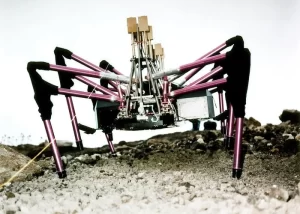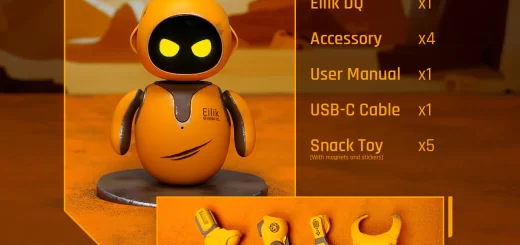DANTE II robot pros, cons, What does Dante 2 do? and Is Dante II designed to explore volcanoes?
Legged robots like DANTE II can navigate uneven terrain and obstacles better than wheeled robots, making them ideal for disaster zones with debris or collapsed structures. These robots are typically built to withstand harsh environments and potential impacts.
DANTE II robot
DANTE II is a legged robot designed for exploration in hazardous environments. DANTE stands for “Disaster Assistance for Navigating Terrains Extremes.” It’s also a nod to Dante Alighieri, the famous author of “Divine Comedy,” referencing the robot’s ability to navigate challenging environments.
The hexapod design is based on insects, specifically cockroaches, known for their agility and ability to navigate tight spaces. DANTE II can climb inclines as steep as 30 degrees and go up and down stairs. It is equipped with infrared and thermal cameras.
DANTE II can operate effectively in low-light or complete darkness, crucial during disaster response. DANTE II can communicate with other robots using a special wireless network, allowing for coordinated search and rescue efforts.
The robot is designed to explore dangerous and potentially “infernal” environments like collapsed buildings or disaster zones. Unlike some wheeled robots, DANTE II can navigate stairs with its hexapod design, making it more versatile in disaster zones with multi-story structures.
DANTE II doesn’t rely on a constant external connection for processing. It has an onboard computer system that allows for some level of autonomous operation. This robot isn’t afraid to get wet. DANTE II is designed to be waterproof, allowing it to operate in flooded areas or during heavy rain.
The design of DANTE II is partially inspired by open-source legged robot projects, highlighting the collaborative spirit of robotics development. DANTE II is designed to navigate disaster zones and could be seen as venturing into an “inferno” of destruction.
DANTE II is equipped with various sensors, including infrared cameras, allowing it to see in low-light conditions, perfect for disaster zones where power might be out. While not the fastest robot, DANTE II can climb stairs, a crucial ability for navigating collapsed buildings.
Advantages of DANTE II
DANTE II is a hexapod (six-legged) robot designed for disaster response situations. Legged locomotion allows DANTE II to navigate rough terrain, climb over obstacles, and access areas inaccessible to wheeled robots. This makes it ideal for search and rescue operations in disaster zones or exploring volcanic landscapes, and rough outdoor environments.
DANTE II’s design might allow it to handle various tasks. It could be equipped with sensors and tools for tasks like collecting samples, inspecting infrastructure, or deploying communication equipment. DANTE II can be operated remotely by human crews, allowing for safer navigation in dangerous environments.
DANTE II’s ability to operate in hazardous environments reduces the risk to human personnel. This could be beneficial in situations involving radiation, toxic chemicals, or unstable structures. Depending on the design of its legs and appendages, Dante II might be able to manipulate objects in its surroundings, offering an advantage over simpler remote-controlled vehicles.
The hexapod design allows for more maneuverability and manipulation capabilities compared to traditional tracked or wheeled robots. This could be useful for tasks like searching for survivors or clearing debris.
Disadvantages of DANTE II
Legged robots are more complex to design and control compared to wheeled robots, This can translate to higher costs and maintenance needs. Legged robots have slower movement speeds and lower payload capacities compared to wheeled robots. This might limit their usefulness in situations requiring rapid response or heavy equipment transportation.
While DANTE II can handle rough terrain, it might still struggle on very loose surfaces like deep sand or snow. Maintaining balance on uneven terrain can be challenging for legged robots, potentially limiting their effectiveness in some situations. Dante II might have limitations in terms of speed or the weight it can carry compared to a wheeled vehicle.
Unless Dante II has specific features for manipulation or carrying objects, its applications might be restricted to exploration and data collection in challenging environments. Legged robots often aren’t as fast as wheeled robots on flat terrain.
You can follow Science Online on Youtube from this link: Science online
You can download the Science Online application on Google Play from this link: Science Online Apps on Google Play
Tracks military technology, Tracked robots use, advantages and disadvantages
Rescue robots (Mobile robots) types, uses, advantages and disadvantages
Humanoid robots use, risks, advantages and disadvantages
Wheeled robots types, uses, advantages and disadvantages
Robotics uses, Robotic programs types, Artificial Intelligence importance and risks
Legged robot features, types, uses, advantages and disadvantages




